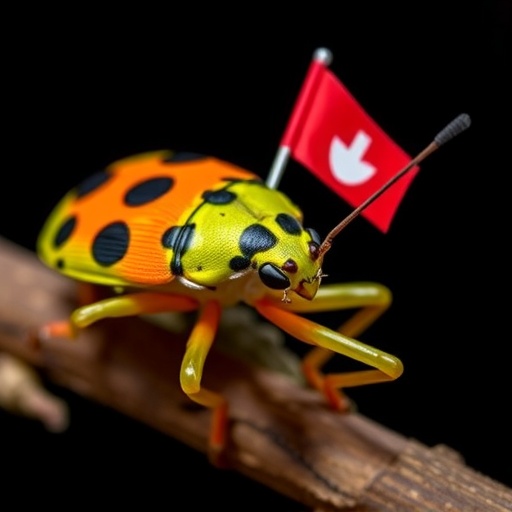Deep within the lush forests of Panama, a remarkable insect has captured the attention of scientists for its peculiar and vibrant behavior. The matador bug (Bitta alipes), known for its striking reddish markings on hind legs, performs an intricate and conspicuous leg-waving display that has perplexed researchers until recently. What was initially believed to be an act rooted in sexual selection has now been unveiled as a sophisticated survival tactic against predation, challenging long-held assumptions about insect communication and behavior.
For years, evolutionary biologists speculated that the vivid leg-waving of the matador bug served as a mating ritual, a form of sexual signaling used by males to attract females or to signal dominance to rivals. However, extensive behavioral observations conducted by researchers at the Smithsonian Tropical Research Institute (STRI) in Panama failed to support this hypothesis. Both male and female bugs engaged in the waving, and the behavior showed no correlation with courtship or reproductive competition, suggesting an altogether different evolutionary driver behind this captivating display.
The breakthrough came with a controlled experimental study, where investigators Connor Evans-Blake, Juliette Rubin, and Ummat Somjee systematically exposed matador bugs to two distinct arthropods: predatory praying mantids and harmless katydids. Over nearly 3,000 instances of leg waving were meticulously recorded, revealing a striking pattern. The bugs sharply intensified their leg-waving displays—by a factor of seven—only in the presence of predators like praying mantids, while exhibiting negligible changes when confronted with non-threatening katydids. This predator-specific behavioral escalation indicated a clear anti-predatory function for the flag-waving display.
Even more compelling was the observation that predatory mantids refrained from attacking bugs exhibiting active waving behavior. This suggests that the matador bug’s leg movements serve as a deterrent, effectively communicating to predators that an attack may be futile or dangerous. Such dynamic and context-dependent behavior reveals a level of adaptive complexity that enriches our understanding of predator-prey interactions and the evolution of defensive strategies in insects.
The research team extended their inquiry beyond a single species, conducting field observations and digital video surveys of related flag-legged insects within the same family. At least five other species exhibited similar waving behaviors, hinting that this anti-predator strategy may be a widespread evolutionary adaptation. All of these species share a diet consisting primarily of passionflower vines, plants known for their chemical defenses, which further suggests an intriguing link between diet-derived toxicity and ostentatious warning signals in the animal kingdom.
Chemical defense is a widespread phenomenon in insects and other animals, often coupled with aposematism—the use of vivid colors or striking patterns to warn potential predators of unpalatability or toxicity. The matador bug’s waving could function as an aposematic display, signaling to predators that the insect harbors chemical defenses obtained from its host plants. However, the precise mechanism by which the waving deters predators remains elusive. It may be a form of motion dazzle that confuses predators’ visual processing, or it could act as an intimidation tactic, mimicking larger or more threatening movements.
This uncertainty underscores a key challenge in behavioral ecology: decoding the nuanced language of animal signals through observation and experimentation. The matador bug’s display may represent a complex blend of evolutionary pressures, combining elements of honest signaling, mimicry, and sensory ecology. Untangling these elements requires further experimental work, possibly involving neuroethological approaches to understand how predators perceive and respond to such dynamic signals.
Senior author Ummat Somjee reflected on the implications of this discovery, noting that insects are among the most diverse and understudied groups of organisms on Earth. Each investigation into their behaviors not only enriches our comprehension of evolution but also broadens our appreciation for the subtle yet powerful ways life adapts to survival challenges. The matador bug’s waving is emblematic of the hidden wonders awaiting discovery in tropical ecosystems.
Beyond its contributions to basic science, this research highlights the importance of biodiversity and conservation. Insects underpin many terrestrial ecosystems through roles in pollination, nutrient cycling, and as foundational elements of food webs. Protecting their habitats ensures the preservation of complex ecological interactions, including the evolutionary arms races between predators and prey.
The study published in Current Zoology marks a significant advance by combining field observations with rigorous experimental methodology, providing compelling evidence that conspicuous, costly behaviors like leg waving in matador bugs serve adaptive defensive purposes rather than reproductive ones. This paradigm shift invites reevaluation of similar traits in other species where function may have been oversimplified or misunderstood.
Though many questions remain—such as the sensory cues predators use to interpret waving signals and the evolutionary pathways leading to such behavior—the research opens new avenues for interdisciplinary collaboration. Understanding the evolutionary ecology of insect signaling could intersect with biomimetic applications in robotics or inform pest management strategies.
In summary, the distinctive flag-waving behavior of the matador bug exemplifies nature’s intricate solutions to survival challenges. Its choreography is not a mere spectacle but a finely tuned anti-predatory adaptation, shaped by evolutionary forces into a defensive dance that wards off enemies. Such discoveries deepen our grasp of biological complexity, reminding us that even the smallest creatures harbor remarkable stories etched by natural selection.
Subject of Research: Animals
Article Title: Flag-waving behavior in matador bugs is an anti-predatory strategy
News Publication Date: 10-Sep-2025
References:
Evans-Blake, C., Rubin, J. J., & Somjee, U. (2025). Flag-waving behavior in matador bugs is an antipredatory strategy. Current Zoology, zoaf047.
Image Credits: Smithsonian Tropical Research Institute
Keywords: matador bug, anti-predatory behavior, leg waving, insect signaling, aposematism, predator deterrence, praying mantids, passionflower vine, chemical defense, evolutionary ecology, insect behavior, tropical biodiversity




